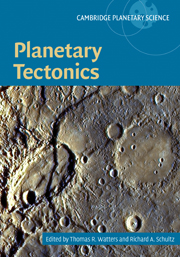Book contents
- Frontmatter
- Contents
- List of contributors
- Preface
- 1 Planetary tectonics: introduction
- 2 The tectonics of Mercury
- 3 Venus tectonics
- 4 Lunar tectonics
- 5 Mars tectonics
- 6 Tectonics of small bodies
- 7 Tectonics of the outer planet satellites
- 8 Planetary structural mapping
- 9 Strength and deformation of planetary lithospheres
- 10 Fault populations
- Index
- Plates
- References
3 - Venus tectonics
Published online by Cambridge University Press: 30 March 2010
- Frontmatter
- Contents
- List of contributors
- Preface
- 1 Planetary tectonics: introduction
- 2 The tectonics of Mercury
- 3 Venus tectonics
- 4 Lunar tectonics
- 5 Mars tectonics
- 6 Tectonics of small bodies
- 7 Tectonics of the outer planet satellites
- 8 Planetary structural mapping
- 9 Strength and deformation of planetary lithospheres
- 10 Fault populations
- Index
- Plates
- References
Summary
Summary
Venus has a pressure-corrected bulk density that is only 3% less than that of the Earth. In contrast, the surface environments of these two planets are very different. At the mean planetary radius the atmospheric pressure and temperature on Venus are 95 bars and 737 K, respectively. Liquid water cannot exist on the surface, which implies the absence of the processes most effective for erosion and sediment transport on Earth. The planet is completely shrouded in clouds, and temperatures of the lower atmosphere do not vary much from equator to poles, resulting in winds not capable of significant erosion. Most of the materials exposed on the surface of Venus apparently formed during approximately the last 20% of solar system history, with no significant clues to conditions on the planet during prior eons. Because the dense atmosphere has destroyed small bolides, the smallest surviving impact craters have diameters of ~2 km, and the total population of impact craters is less than 1000. The dominant terrain on Venus is plains, which constitute ~80% of the planet's surface. Impact craters are randomly distributed on these plains, and thus differences in the relative age of surface materials based on differences in crater frequency are not statistically robust.
The global topography of Venus does not include the diagnostic plate-boundary signatures that are present on Earth, and thus plate tectonics has not been active on Venus during the time represented by the current surface materials and features.
- Type
- Chapter
- Information
- Planetary Tectonics , pp. 81 - 120Publisher: Cambridge University PressPrint publication year: 2009



